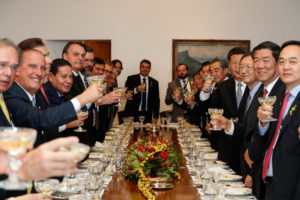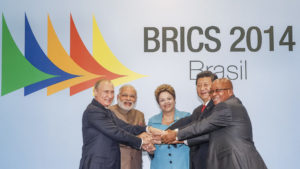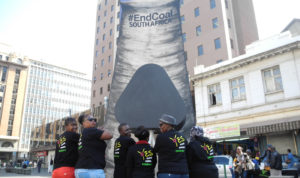Leaders from Brazil, Russia, China, India, and South Africa met for the 11th BRICS summit in Brasilia this week to discuss the future of the bloc and identified loans supporting sustainable development from the New Development Bank (NDB) as a key element in strengthening integration.
NDB president Kundapur Vaman Kamath said that the bank must expand partnerships with private investors and stimulate loans in local currencies.
“We note with appreciation the role of the New Development Bank in infrastructure and sustainable development financing”, BRICS leaders wrote in a joint statement issued at the close of the Summit.
Presidents Jair Bolsonaro (Brazil), Vladimir Putin (Russia), and Cyril Ramaphosa (South Africa), as well as Indian prime minister Narendra Modi and Chinese leader Xi Jinping signed the document. “We express our commitment to sustainable development in its three dimensions – economic, social and environmental – in a balanced and integrated manner”, the text states.
Welber Barral, a former Brazilian secretary of foreign trade, said that infrastructure projects account for most loans from the NDB, whose governors also met in Brasilia, but decisions on how sustainable each project will be are determined by each government.
Building BRICS
Ten years after the bloc was created, the BRICS are not the new global sensation they once were. While they initially represented a new and powerful voice from the developing world, forming the NDB and negotiating blocs in international climate talks, today they can seem a disjointed collection of countries.
Even so, the geopolitical importance of the group is still undeniable. They are five of world’s largest economies, populations, and territories. What BRICS does still very much matters.
“The BRICS are great powers for major development and wealth that joined together as a force that was an alternative to what existed previously,” says Marcio Azambuja, former secretary general of Brazil’s ministry of foreign relations. “But they need to find their way and their vocation. It is an idea that is still seeking a common agenda.”
Our initial plan was to reshape the Washington institutions
Oliver Stuenkel, a professor of international relations at think-tank the Getúlio Vargas Foundation, says that the BRICS group is now much more institutionalised, with more than 100 annual meetings, and has helped tilt Brazil’s world view towards Asia.
“Its importance [to the bloc] is highly significant“, he tweeted.
The first BRICS summit was held in 2009 in Ekaterinburg, Russia and its inaugural members (Brazil, Russia, India and China) met more informally in the following few years. The group’s acronym was identified at the beginning of the century by Goldman Sachs economist Jim O’Neill.
Since then, they have become a strong bloc in climate negotiations, represented by the Basic group, which excludes Russia, and which made treaties possible when, previously, developing nations had stalled talks, refusing to make the same commitments as historical polluters.
One of BRICS’ first agendas centred on reforming international finance mechanisms, according to Paulo Nogueira Batista Jr., who was part of the process of creating BRICS as a Brazilian representative to the International Monetary Fund.
“Our initial plan was to reshape the Washington institutions,” he says.
At the Brasilia summit, the group noted the establishment the NDB’s Americas regional office in São Paulo, and a sub-office in Brasilia. The bank, whose headquarters are in Shanghai, also plans to open offices in Moscow in Russia and India next year.
Though the NDB pledges to develop measures to mitigate against climate change, and 16 of the NDB’s 42 approved loans have been for renewable energy projects, it defers to recipient countries’ environmental standards.
This means that the NDB, despite promising to be a revolutionary tool for sustainable development, has not ruled out investing in coal power.
Instead, it pledges to: “Adopt clean production processes and good energy efficiency practices. Avoid pollution, or, when avoidance is not possible, minimize or control the intensity or load of pollutant emissions”.
Earlier this year, the NDB loaned US$480 million for the installation of desulpharisation units at South Africa’s Medupi coal-fired plant earlier this year.
Critics have said the bank’s environmental policies are vague and it suffers from a lack of imagination on what sustainable development can look like.
BRICS summit commits to sustainability
During this week’s 11th BRICS summit, leaders reiterated commitments to the 2030 Agenda for Sustainable Development and implementation of the Paris Agreement.
In a statement, leaders also stated that they expect that the first replenishment of the Green Climate Fund (GCF) “by the end of 2019 will significantly exceed the initial resource mobilisation”.
They also restated their commitment to working for the success of COP25 climate talks, which have been relocated from Santiago, Chile, to Madrid.
These are five countries, and none accepts the hegemony of another. This leads to operational problems
On the first day of the event, talks focused mainly on trade. Bolsonaro and Xi met and signed bilateral agreements, including sanitary protocols for exporting products such as pears and melons. Xi Jinping and Vladimir Putin criticised protectionist barriers, at a time when China is engaged in a trade war with the US.
Paulo Guedes, Brazil’s minister of the economy, also said that the Brazilian government is negotiating a free trade zone with China.
However, South American common market Mercosur’s rules prevent members from signing bilateral accords involving tariff exemptions. China and Mercosur have been studying the feasibility of a free trade agreement.
According to the O Estado de S.Paulo newspaper, talks have not yet included the free trade zone, but involve broadening the range of items available for export.
BRICS challenges
Some years since their headline-grabbing formation, BRICS’ profile has lowered.
Brazil’s promise to become an international economic powerhouse has not materialised. The same is true of South Africa, which joined the group in 2011. The relationship between India and China soured, and Russia became the target of various sanctions. Coordination between such different nations was already difficult, and only became more arduous.
Azambuja explains that coordination has always been a challenge for the BRICS. Historically, blocs comprised of different countries have been constructed through geographical proximity, by winners of a war, or by hegemonic powers. Not BRICS.
“These are five countries, and none accepts the hegemony of another. This leads to operational problems,” he explains. “How can I transform great ideas into operational plans? It’s very complicated.”
Despite their challenges, it seems unlikely any of the countries will exit the group. The status that participation implies for Brazil and South Africa, which no longer have the geopolitical influence they once had, is highly-prized.
According to Paulo Esteves, coordinator of the BRICS Policy Centre, the world order has changed for and because of BRICS.
“Today, the world seems much more like a world built in the image of the BRICS,” he says. “A world with multiple centres of power, rather than just the image of the west.”





![Chief Minister Hafiz Hafeezur Rehman of Gilgit-Baltistan talks to reporters [image by: Peer Muhammad]](https://dialogue.earth/content/uploads/2019/11/IMG_20191120_174847-1-300x295.jpg)


